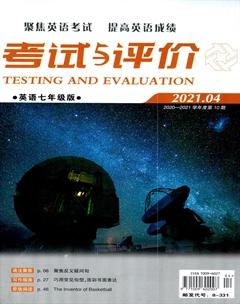There be句型解读
沈莹
【基本概念】
There be句型表示某处有某物或某人。there是引导词,在句中不充当任何成分,翻译时也不必译出。
句式结构:There+连系动词be+主语(人/物)+地点(介词短语或副词)。
(1) There is +单数可数名词/不可数名词+地点状语。
(2) There are +复数名词+地点状语。
名词及主谓一致:
① 当主语是可数名词单数或不可数名词时, be动词用is。如:
There is a bird in the tree. 树上有一只鸟。
② 当主语是可数名词复数时,其be动词就用are。如:
There are two children in the room. 房间里有两个孩子。
③ 当主语是两个或两个以上的名词时,(遵循就近原则)be动词要根据离它最近的名词的数来确定be的形式。如:
There is a teacher and many students in our classroom. 我们教室里有一位老师和许多学生。
There are two boys and a girl under the tree. 树下有两个男孩,一个女孩。
【There be句型转化】
1. 如何改为否定句:直接在be后加上not或no。如:
There are some pictures on the wall. → There arent any pictures on the wall. = There are no pictures on the wall.
There is a bike behind the tree. → There isnt a bike behind the tree. =There is no bike behind the tree.
注意:肯定句中有some时,改为否定句或者疑问句时要将其改为any,而and则要改为or。not和no的不同之处在于not是副词,no为形容词,not a / an / any + n. 相当于no + n.。
2. 如何改为一般疑问句:把be动词提到句首,句末句号改成问号。同时应注意:当肯定句中有some时,要将其改为any,而and要改成or。如:
There is some water on Mars. → Is there any water on Mars?
There are some fish in the water. →Are there any fish in the water?
在构成一般疑問句时, 其句型结构为:
(1) Is + there + a / an+单数名词+介词短语?
(2) Is + there+不可数名词+介词短语?
(3) Are + there + any +复数名词+介词短语?
回答用Yes, there is / are. 或No, there isnt / arent. 如:
—Is there a ball on the table? 桌子上有个球吗?
—Yes, there is. 是的,有。
—No, there isnt. 不是,没有。
—Are there any children near the door? 门边有些孩子吗?
—Yes, there are. 是的,有。
—No, there arent. 不是,没有。
3. 如何改为特殊疑问句:必须了解是对什么进行提问,懂得用哪个词去发问。
(1) 对主语提问:当主语是人的时候,则用who 引导,当主语是物的时候,则用what 引导。
注意:无论原句的主语是单数还是复数,对之提问时一般都用be的单数形式(回答时却要根据实际情况来决定)。如:
There are many things over there. →Whats over there?
There is a little girl in the room.→Who is in the room?
(2) 对地点状语提问:则用where 引导。如:
There is a computer on the desk. → Where is the computer?
There are four children on the playground. →Where are the four children?
(3) 对数量提问:一般有两种句型结构,以下两种句型主要用来询问“某处有多少人或物”。如:
① How many+复数名词+are there+介词短语?
② How much+不可数名词+is there+介词短语?
How much milk is there in the bottle? 瓶子里有多少牛奶?
How many students are there in your class? 你们班有多少学生?
【拓展】
1. 在There be结构中,live, lie, stand等表示“存在”意义的不及物动词也可作为谓语动词放在there be句型中。如:
Long, long ago, there lived a king in this area. 很久很久以前有个国王住在这儿。
2. There be 句型与have句型的区别
There be句型与have (has)均表示“有”,但There be句型强调“某处有某人/某物”,着重“存在”的状态;have则强调“某人有某物”,着重“拥有”。如:
He has two sons. 他有两个儿子。
There are two men in the office. 办公室里有两个男人。
当have表示“包括”“存在”的含义时,There be 句型与其可互换。如:
A week has seven days. = There are seven days in a week. 一个星期有七天。
There are three children in my family. 我家里有三个孩子。
I have three children. 我有三个孩子。

